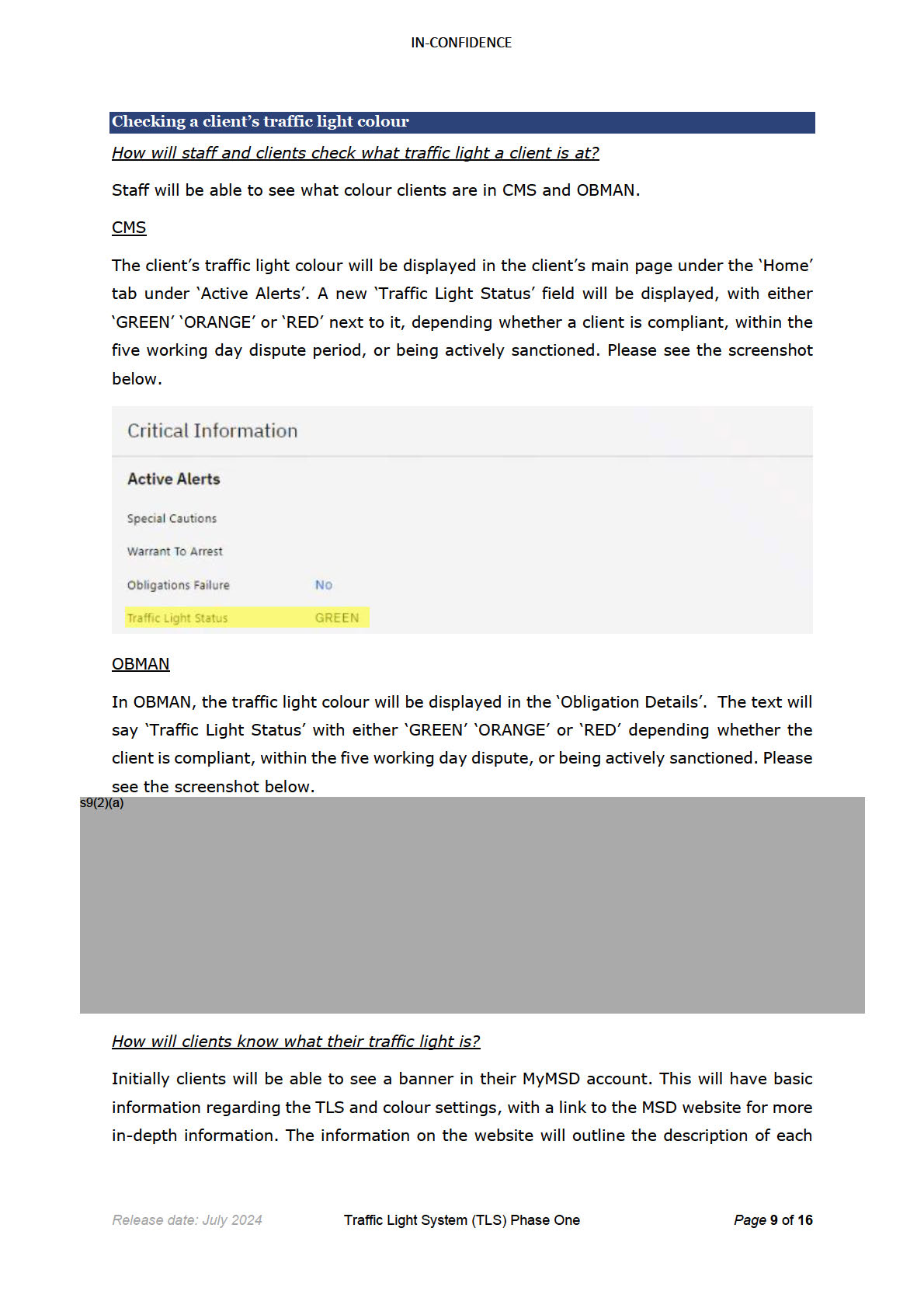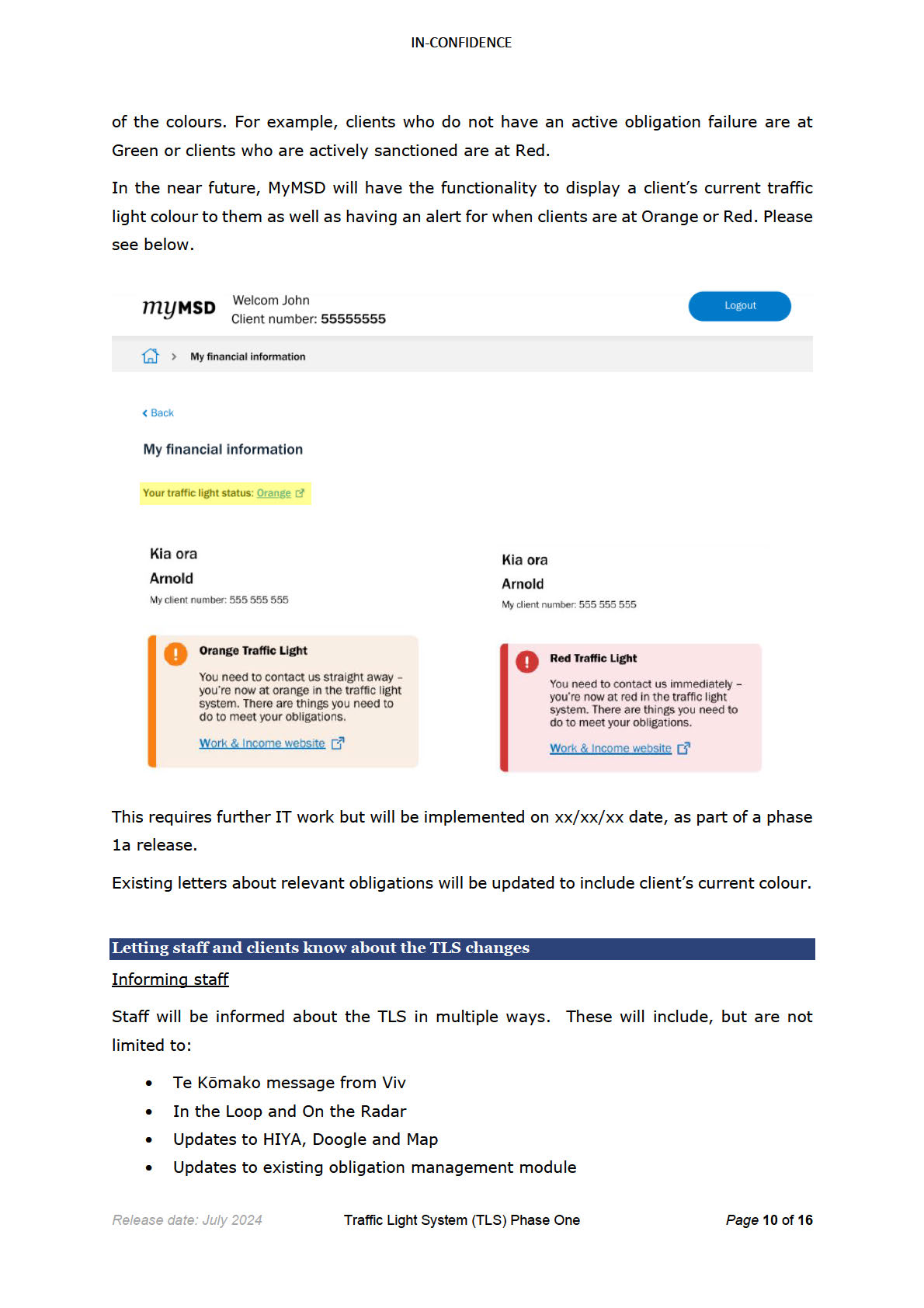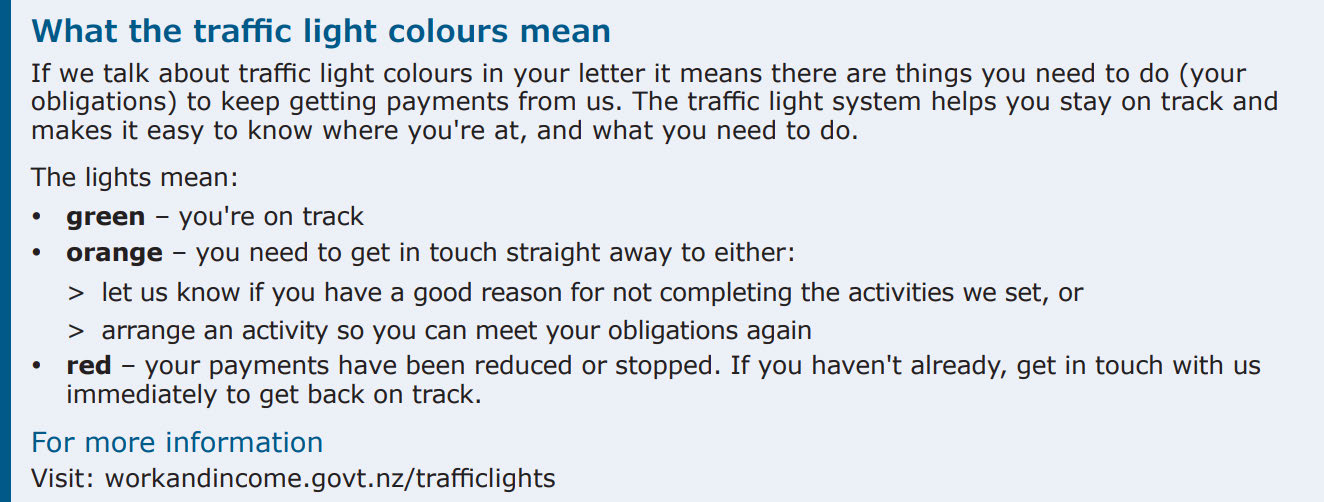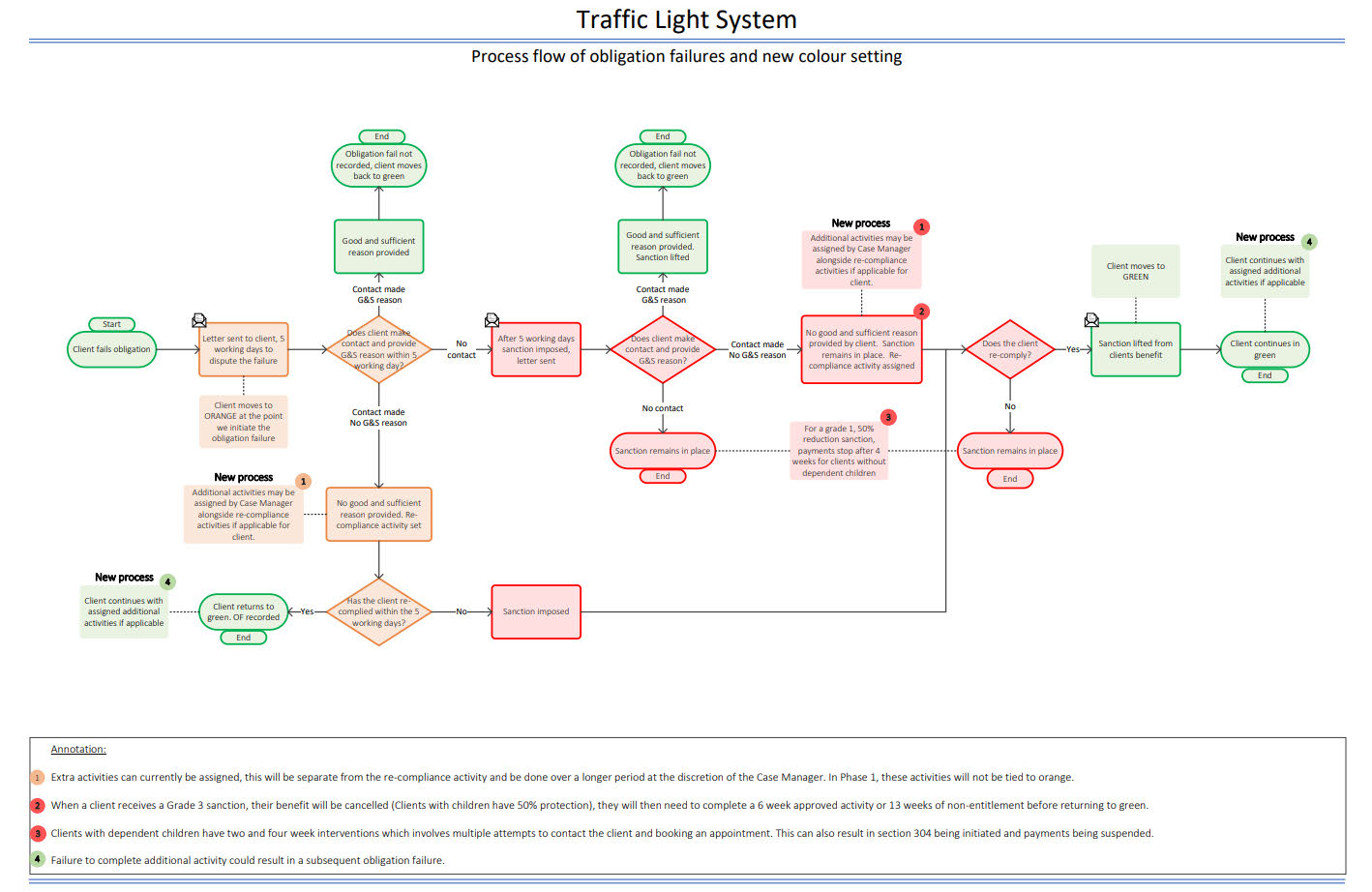
IN-CONFIDENCE
Service Delivery
Traffic Light System Phase One
Business Process
July 2024
Owner:
Out of scope
Author:
Out of scope
Version:
1.0
Objective Ref:
Release Date:
July 2024
Release date: July 2024
Traffic Light System (TLS) Phase One
Page 1 of
16
IN-CONFIDENCE
Sign off
This form records the approval and acceptance of the following document:
Doc
ument Name
Version
EDRMS File Reference
The following signatures indicate approval and acceptance of the above document, subject
to any caveats listed below.
Name
Role
Signature/Date
Out of scope
Director
Income Portfolio
Out of scope
– via email
26/07/2024
Caveats:
……………………………………………………………………………………………………………………
……………………………………………………………………………………………………………………
_______________________
____/____/____
Caveats:
……………………………………………………………………………………………………………………
……………………………………………………………………………………………………………………
_______________________
____/____/____
Caveats:
……………………………………………………………………………………………………………………
……………………………………………………………………………………………………………………
_______________________
____/____/____
Caveats:
……………………………………………………………………………………………………………………
……………………………………………………………………………………………………………………
Release date: July 2024
Traffic Light System (TLS) Phase One
Page 2 of
16
IN-CONFIDENCE
Contribution List
Version
Date
Author
Contribution from
Comments/
Feedback
1.0
21/06/2024
Out of scope
1.1
04/07/2024
Out of scope
Out of scope
1.2
05/07/2024
Out of scope
Out of scope
1.3
26/07/2024
Out of scope
Out of scope
Release date: July 2024
Traffic Light System (TLS) Phase One
Page 3 of
16
IN-CONFIDENCE
Contents
Sign off ................................................................................................................................. 2
Contribution List .................................................................................................................... 3
Purpose ................................................................................................................................ 5
Background ........................................................................................................................... 5
Overview ............................................................................................................................... 6
What is the Traffic Light System ............................................................................................ 6
Transitioning between colours ............................................................................................... 7
Additional activities ............................................................................................................... 8
Checking a client’s traffic light colour .................................................................................... 9
Letting staff and clients know about the TLS changes ......................................................... 10
Letters being changed ......................................................................................................... 11
Onboarding clients into the TLS .......................................................................................... 11
What’s not changing............................................................................................................ 11
Appendix one ...................................................................................................................... 13
Appendix two ...................................................................................................................... 15
Release date: July 2024
Traffic Light System (TLS) Phase One
Page 4 of
16
IN-CONFIDENCE
Purpose
This document outlines business process for overlaying the Traffic Light System onto the
curr ent obligation and sanction regime.
It should be read in conjunction with the Phase One TLS Operational Policy Design,
objective reference: A16248646
Background
Please refer to the reports sent to Hon Louise Upston REP/24/5/503, REP/24/6/564 and
REP/27/7/638
Release date: July 2024
Traffic Light System (TLS) Phase One
Page 5 of
16
IN-CONFIDENCE
Overview
The new government has stated in their manifesto they want to do more to get jobseekers
off t he benefit and into suitable work. To help enable this, they are introducing a Traffic
Light System (TLS) to make it clearer to clients how compliant they are, what the
consequences are for not meeting their obligations and to expand the toolkit MSD staff
have to respond to this.
The TLS will be implemented in two phases. Phase One will be implemented on 12 August
2024. This will involve onboarding all existing clients with work, work preparation and
social obligations and assigning them a traffic light colour, based on their level of
compliance at go-live. If a client fails an obligation, additional activities or training
opportunities may also be assigned for them to complete if MSD determines that it is
appropriate.
What is the Traffic Light System
The TLS is a new communications tool which allows staff and clients to identify a client’s
current level of compliance easily and clearly. This is done by having one of three colours
assigned to clients.
These are:
• Green – a client is complying with their obligations and no intervention is
required,
• Orange – a client has failed an obligation and they have five working days to
dispute the failure or arrange a re-compliance activity,
• Red – a client is actively sanctioned and has not yet re-complied.
The definitions of each colour are as follows:
Green
Clients are at Green when they are complying with all their work-related and social
obligations. This is the colour most clients will be in most of the time. Unless clients have
an active obligation failure on 12 August 2024, they will be onboarded to Green. Clients
move from Green to Orange if they have failed to meet an obligation and MSD has not
been advised there was a good and sufficient reason for the failure. Once a client has re-
complied or a failure is overturned and their sanction (if imposed) is lifted, they will move
back to Green.
Release date: July 2024
Traffic Light System (TLS) Phase One
Page 6 of
16
IN-CONFIDENCE
Orange
Clients are at Orange for the five working day dispute period after they have failed an
obligation. During this time, they can dispute the failure if they have a good and sufficient
reason for the failure or re-comply. If they dispute and the failure is overturned, or they
re-comply within the five working days, a sanction is not imposed, and they will return to
Green.
Red
Clients are at Red when the five working day dispute period has passed, and a sanction
has been imposed. Clients will remain at Red until MSD is satisfied the client has started
their re-compliance activity and their sanction is lifted or their obligation failure is
overturned. When this happens, they will return to Green.
While clients are at Red, they are expected to engage with MSD and re-comply.
Who is included in the TLS?
The Traffic Light System applies to clients who have:
• Work obligations, either part or full time
• Work preparation obligations
• Social obligations
Note: work and work preparation obligations include Work Ability Assessments, working
with contracted service providers and attending an interview even if they have an
obligation exception.
If clients with these obligations fail to meet them without a good and sufficient reason,
their benefit will be sanctioned until they re-comply.
Transitioning between colours
The TLS colours will be managed by OBMAN. Staff won’t need to do anything to initiate a
change to the client’s colour. When MSD staff initiates an obligation failure, it will trigger
the move from Green to Orange.
Clients will transition between colours based on their current level of compliance. Clients
will start in Green and will stay Green unless they fail an obligation. For example, this
could be because they failed to attend an appointment or a seminar.
Once an obligation failure has been initiated, the client will move to Orange. A letter will
be issued advising they have;
• failed an obligation, and
• that a sanction will be imposed if they don’t have a good reason for failing, and
Release date: July 2024
Traffic Light System (TLS) Phase One
Page 7 of
16
IN-CONFIDENCE
• to contact MSD to talk about what they need to do to re-comply.
Clients then have five working days to dispute the obligation failure by providing a good
and sufficient reason for failing to meet the obligation. They may also re-comply with their
obligation within this timeframe. If they have a good reason, or re-comply within this
time, they will move back to Green.
If clients don’t provide and good and sufficient reason to MSD or re-comply within that
timeframe, a sanction will be imposed on day six, and they will move to Red.
Clients will remain in Red until they re-comply (or their sanction is overturned, if they had
a good and sufficient reason for failing).
If a client is on their first or second failure, a standard re-compliance activity is set by MSD
staff. The re-compliance activity must be the same or substantially similar to the activity
they have failed to do.
If a client has failed for a third time, or refuses a suitable job offer with no good and
sufficient reason, they move to Red and are subject to a 13-week non-entitlement period.
Clients may complete a 6-week re-compliance activity and be granted a provisional
benefit. If they complete the activity to a satisfactory standard, the remainder of the non-
entitlement period is waived.
Additional activities
After clients have failed their first or second obligation in a 52-week period, they may have
additional activities assigned to them by MSD.
The client must complete any activities assigned to them after they have re-complied. A
subsequent failure may be initiated if these are not completed without and good and
sufficient reason.
Staff should talk with clients at their appointment where the re-compliance activity is
assigned to them, to determine whether additional activities are appropriate for them.
Additional activities could be assigned either while the client is at Orange, if this happens
during the five working day period or at Red, when clients have already been sanctioned.
Additional activities could include, but are not limited to:
• more frequent check-ins with case manager
• providing proof of job search
• attending seminars
• participating in training programmes.
Release date: July 2024
Traffic Light System (TLS) Phase One
Page 8 of
16



IN-CONFIDENCE
Clients
Ahead of go-live, clients will be sent information via an email campaign about the TLS and
what to expect from these changes. Information on the Work and Income website will also
be updated.
Letters being changed
Once the TLS has gone live, letters sent to clients about obligation failures, sanctions or
re-compliance will include information about a client’s colour, so that they are easily able
to identify where they are in the TLS.
The letters will also have a brief explanation on the boiler plate of what the colours mean
for the client. See below.
Onboarding clients into the TLS
The system will manage onboarding automatically. On 12 August 2024, clients with work-
related and/or social obligations will move to Green if they don’t have an active obligation
failure on their record. Any clients who are in the five working day dispute period following
a failure will move to Orange. Any clients with active sanctions will move to Red.
Any new clients coming onto a benefit from go-live automatically be set at Green following
the grant of their benefit. The TLS will be explained to them as part of new application
conversations.
What’s not changing.
The process for imposing obligation failures and sanctions
The obligation failure process is not changing with the introduction of the TLS. Before a
staff member initiates an obligation failure, they must be satisfied that the client has no
Release date: July 2024
Traffic Light System (TLS) Phase One
Page 11 of
16
IN-CONFIDENCE
good and sufficient reason for the failure, or have made a reasonable effort to contact the
client to check this.
If the staff member is unsuccessful or the client has advised there was no good and
sufficient reason, the staff member will initiate the failure in CMS, in the client’s service
plan. MSD will advise clients that they will need to re-comply or provide a good and
sufficient reason before their obligation failure is overturned or re-complied.
Obligation failure count period
Phase one will retain the current obligation failure settings. Each obligation failure is
recorded on a client’s file for 12 months and then drops off.
For example: a client fails an obligation on 12 April 2024. They had no good and sufficient
reason for failing, so it’s upheld, and the client re-complies. The client fails to meet their
obligations a second time on 6 September 2024. This increases the client’s obligation
failure count to two. The client re-complies and doesn’t fail again. On 12 April 2025, their
first obligation failure drops off the client’s record, reducing their failure count to one. The
second failure remains on file until 6 September 2025, which then reduces their failure
count to zero.
The grade of sanction that is imposed depends on what the client’s obligation failure count
is at the time they fail an obligation.
Graduated sanction regime
Phase one will be retaining the current settings of a three step graduated sanction regime
that is imposed when a client fails an obligation.
The sanction regime for a rolling 12-month period is as follows:
• First failure, grade 1 sanction 50% reduction to benefit
• Second failure, grade 2 sanction suspension of benefit
• Third failure, grade 3 sanction cancelation of benefit
For clients with dependent children there is a 50% protection for their benefit rate. This
is as follows:
• Grade 1 sanction 50% reduction to benefit
• Grade 2 sanction 50% suspension of benefit
• Grade 3 sanction 50% cancelation of benefit
If a client refuses an offer of a suitable job without a good and sufficient reason, they are
given a grade 3 sanction regardless of their obligation failure count.
Note: if clients with dependent children do not contact MSD to re-comply, their benefit
may be stopped under a section 304 review.
Release date: July 2024
Traffic Light System (TLS) Phase One
Page 12 of
16
IN-CONFIDENCE
Appendix one
How do MSD systems ‘talk’ to one another?
Once a failure is launched in CMS, OBMAN will register the failure and:
• work out the date five working days in the future for when the sanction takes effect
• update the client’s colour from Green to Orange
• increase the obligation failure count
• communicate with CMS to update the client’s colour from Green to Orange
• issue the notice of obligation failure and sanction letter through ECS
If a client makes contact within the five working days and provide good and sufficient
reason for the failure, it will be overturned. This will still be done through OBMAN which
will:
• remove the future sanction date
• update the client’s colour from Orange to Green
• decrease the obligation failure count
• communicate with CMS to update the client’s colour form Orange to Green
• issue a letter through ECS.
If a client makes contact and re-complies within the five working days, the sanction will
not take effect, however the obligation failure will still count. MSD staff should lodge the
re-compliance through CMS which will update OBMAN. OBMAN will then:
• remove the future sanction date
• update the client’s colour from Orange to Green
• communicate with CMS to update the client’s colour from Orange to Green
• issue a letter through ECS
If a client does not re-comply or dispute the failure within the five working day period, a
sanction will be imposed. This is initiated in OBMAN which will:
• communicate with SWIFTT to impose the sanction
• update the client’s colour from Orange to Red
• communicate with CMS to update the client’s colour from Orange to Red.
SWIFTT will send a letter to clients advising of the change to their payments due to the
sanction. The sanction will remain in place and client’s colour will stay Red until they
either re-comply or have the obligation failure overturned.
Release date: July 2024
Traffic Light System (TLS) Phase One
Page 13 of
16
IN-CONFIDENCE
Once a client has re-complied, the sanction can be lifted. This is initiated in CMS which
will update OBMAN. OBMAN will then:
• communicate with SWIFTT to lift the sanction
• update the client’s colour from Red to Green
• communicate with CMS to update the client’s colour from Red to Green.
SWIFTT will send a letter to clients advising of the change to their payments due to the
removal of the sanction.
To re-comply after a grade 3 sanction, clients need to engage in a six-week approved
activity. While they are completing this activity, they are granted a provisional benefit. To
grant the benefit, the obligation failure must be re-complied in OBMAN at the beginning
of their six-week approved activity. Clients who are receiving a provisional benefit should
be at Red. Due to system constraints, clients will show as being at Green while they receive
their provisional benefit. Phase two will update this so they are at Red during this time.
Release date: July 2024
Traffic Light System (TLS) Phase One
Page 14 of
16

IN-CONFIDENCE
Appendix two
Release date: July 2024
Traffic Light System (TLS) Phase One
Page 15 of
16

IN-CONFIDENCE
Release date: July 2024
Traffic Light System (TLS) Phase One
Page 16 of
16





